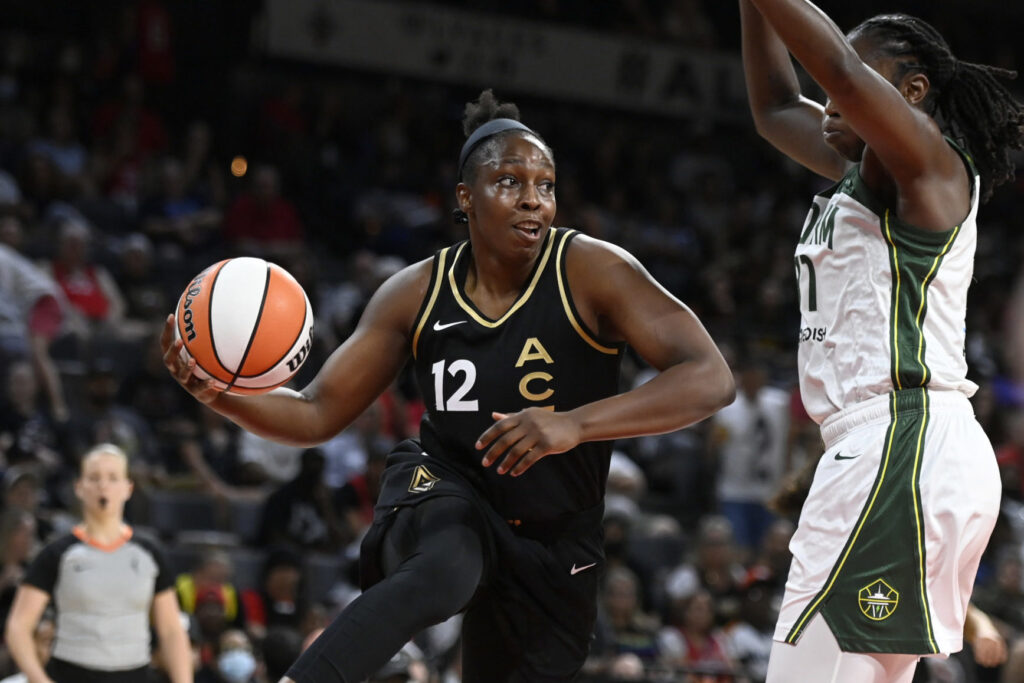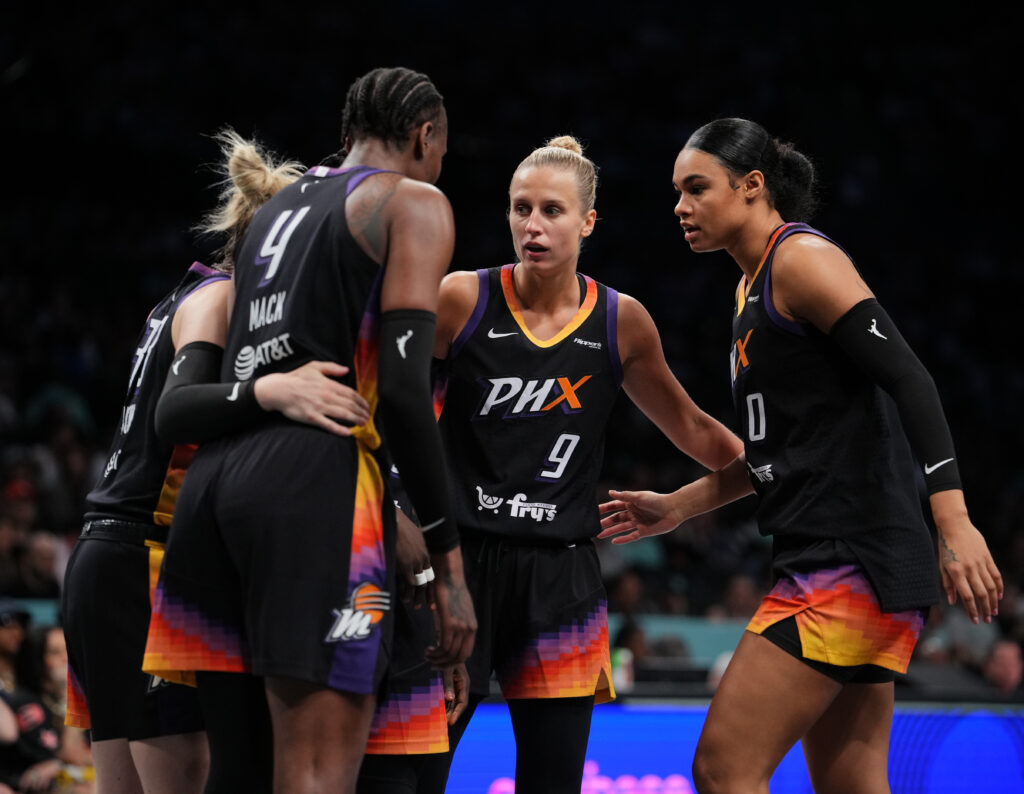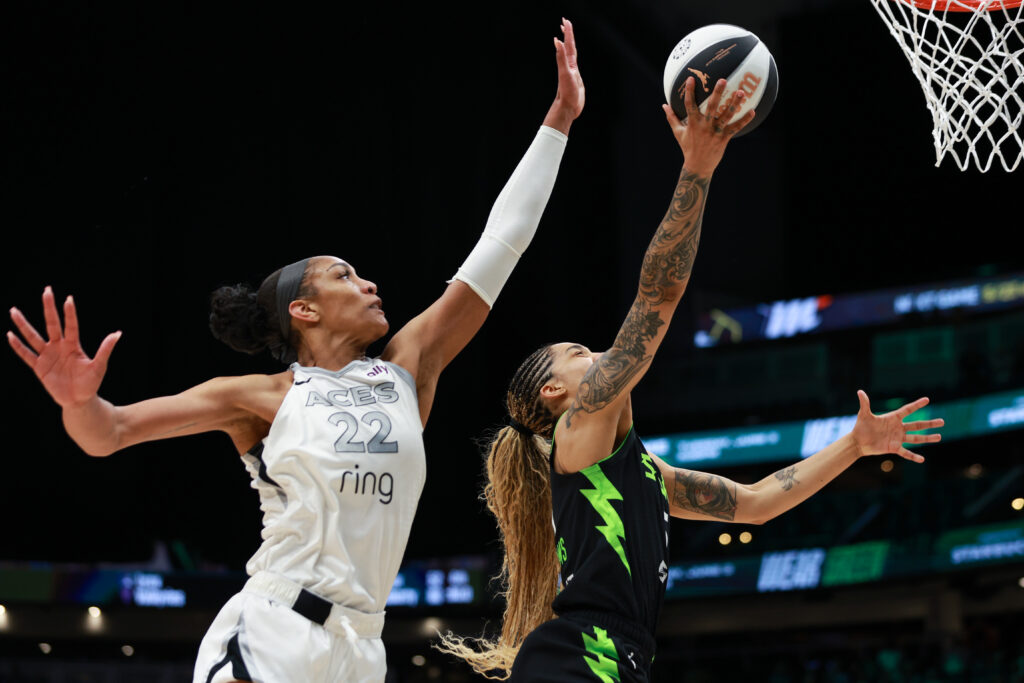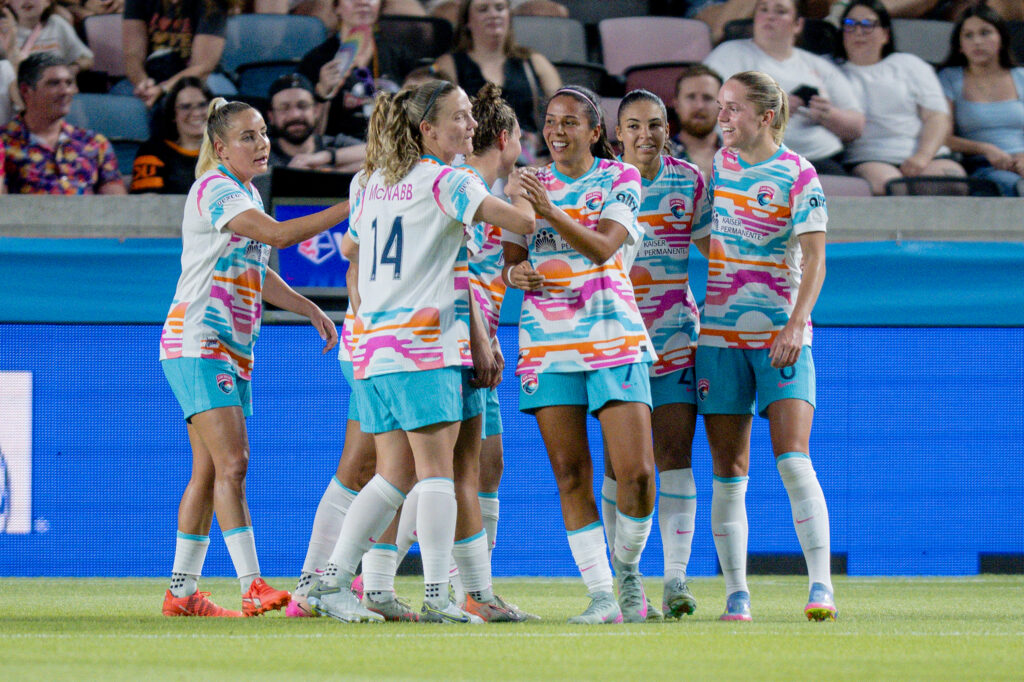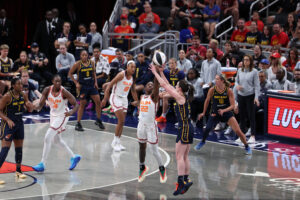The first Chelsea Gray behind-the-back pass in history took place in the front yard of her childhood home.
Gray, who grew up in the Bay Area, had the typical driveway basketball hoop. The kind with a rectangular plastic base, filled with sand to keep it from falling over. In addition to practicing her shooting, Gray liked to use the basket in an unconventional way.
From the moment she started playing basketball, Gray fell in love with the art of passing. She watched film of Ticha Penicheiro, Magic Johnson and Jason Williams, seeking to emulate the vision and artistry they used to create for their teammates.
But Gray didn’t always have a teammate to catch her passes, so she had to innovate.
She’d angle herself away from the hoop in front of her house, and throw the ball behind her back, aiming for the pole that held up the backboard. Perfection was key. Because even if she made contact with the pole, if the pass didn’t hit the exact center, the ball would ricochet out of the driveway, and with a few bounces, it would be down the street.
So, Gray simply didn’t miss.
And once she connected the first time, she was hooked.
“I thought it was the coolest thing,” she said. “The first one I threw probably barely got there. After that, I wanted to try it all the time.”
Gray’s dad kept that hoop long after it had outlived its usefulness. She remembers using it so much that eventually, a hole was worn through the backboard. After that, she had to practice shooting without the glass. In her first few seasons in the WNBA, Gray would come home from Los Angeles — where she was playing for the Sparks — and put up a few shots on the decaying hoop for old times sake. And when her dad finally got rid of it, it felt like the end of an era.
Because it was on that hoop that the Las Vegas Aces’ Point Gawd learned to pass.

Sitting between teammates A’ja Wilson and Kelsey Plum, Chelsea Gray, with a backwards hat and megawatt smile, takes in the scene. The three — and coach Becky Hammon’s son, Cayden — are answering questions after the Aces topped the Chicago Sky 93-83 in the Commissioner’s Cup Championship game.
A reporter asks about Gray, who was named MVP of the game with 19 points, five assists and four rebounds, and Plum scoots closer to the microphone. What she has to say is important, and she wants to make sure everyone hears.
“I want to, for the record, set it straight. She’s the best point guard in the world,” Plum says.
As she talks, Gray looks down at the table.
Threading passes and scoring in the clutch, that’s easy. But Gray is always one to let her play speak for itself, so she shifts in her seat as Plum continues: “She’s the clutchest player in the WNBA. Ask anyone, ask any GM, any coach, any player.
“And she got snubbed this year,” Plum said of Gray being left off the All-Star list.
This causes Gray to put her head in her hands and rub her eyes. She looks slightly uncomfortable, but never ungrateful, and as her teammate continues her speech, Gray’s mouth forms into a slight smile.
“She doesn’t get the love and credit she deserves, and I’m really, really glad people saw that tonight,” Plum said.
Gray admits that the All-Star snub in her second season with the Aces “made her feel some type of way,” and she’s had a chip on her shoulder ever since.
“I’m not always the one that is going to be super loud and yelling about what I’ve done, ” Gray said. “I let my work speak for itself, but it was really nice to have one of my teammates say what I don’t always say.”
Got me emotional man. Thanks KP for this! 🤞🏾♥️ https://t.co/zuVI2yl9uK
— Chelsea Gray (@cgray209) July 27, 2022
Her resume backs up Plum’s statement as well.
While Gray was playing at Duke, her talent was so undeniable that even after missing part of her junior season and most of her senior season with a fractured kneecap, Connecticut still selected the point guard 11th overall in 2014.
After taking two seasons to settle in, first with the Sun and then with L.A. after a 2016 trade, Gray blossomed. In 2017, she started for the Sparks and averaged 14.8 points and 4.4 assists per game. Since then, she’s started every game she’s appeared in and seen her assists average rise to 6.1 with Las Vegas this season.
Gray’s been an All-Star four times and All-WNBA twice. She’s won a Spanish League championship, a Turkish League championship, a WNBA title and a gold medal with Team USA in 2020.
She’s had success in every way possible, picking up the nickname “Point Gawd” along the way.
Any team that wants to win wants Chelsea Gray. It’s why the Aces went after her so vehemently when she was a free agent in 2021, and why Joanne P. McCallie traveled from Durham, N.C. to Stockton, Calif. to recruit her, even bringing her 10-year-old son, Jack, along to watch Gray.
Now, Jack is older than Gray was at the time, but he remembers the first time he saw her play.
“She even threw a behind-the-back pass in that game,” he says. “I was like, “Wow, she is so good.’ And I was really excited for her to come to Duke.”
When she arrived on campus, Gray was everything Jack hoped for. He loved watching her artistry on the court and how sometimes she celebrated a big shot by sticking out her tongue. He also loved how she treated him.
Gray made it a priority to talk to Jack every time she saw him. It made him feel cool, like he belonged. Gray even went to his first middle school basketball game.
The gym, she says, was tiny and she could barely sit down. But that didn’t matter much, since Gray spent most of the time standing up to cheer for No. 12, the same number she wore.
Coach McCallie still remembers Jack doing a project in fifth grade where he was tasked with writing about his hero. Other kids picked their parents, NBA players or famous figures from history. He picked Chelsea Gray.
“He’s still a fan of hers today,” McCallie said. “He’s older, of course, but that hasn’t changed.”
His mom is also a fan. Coach McCallie knew from that first recruiting trip to St. Mary’s High School that Gray was special. She was struck by the point guard’s natural affinity for basketball, her obsessive desire to get better, and the way she saw the game.
When Gray got hurt during her junior year, it was crushing for McCallie and the Blue Devils. But without her star guard on the floor, McCallie did the next best thing: She made her a coach.
Gray sat on the first chair on the bench, right next to her coach. And when McCallie drew up plays in the huddle, Gray was there to contribute her thoughts. Even when she couldn’t play, Gray found a way to help her team.
“She has this incredible vision,” McCallie said. “She sees things developing way ahead of everyone else. And she’s got this ability to elevate everyone around her.”

McCallie can see Gray coaching someday, when her playing career is over. But for the time being, Gray is a coach on the floor, like all great point guards. And just like her son, McCallie remains an avid supporter.
McCallie, who is now an author, could fill a book with her plaudits of Gray. But she doesn’t have to. One sentence sums it all up.
“She’s a better passer than Magic Johnson,” McCallie says without hesitation.
Watch any highlight reel of Gray, and you’ll see her awe-inspiring passes. Play with Gray, and you’ll be the recipient of them. Just make sure you’ve got your hands up.
Alle Moreno, who was Gray’s teammate in high school and now coaches at their alma mater, says the team had a running joke when it came to their point guard.
“She’s got that famous no-look pass that she can throw on a dime, 92 feet,” Moreno said. “And we used to joke that if she was looking at you, she’s probably not gonna pass to you. And if she’s not looking at you, then you better be ready.”
***
No one knows Gray’s game better than her wife, Tipesa Gray.
She’s been there every step of Chelsea’s WNBA career, and as a former basketball player herself — then Tipesa Moorer, she spent four years at Long Beach State — Tipesa can almost see the game through Chelsea’s eyes.
Almost.
Even after about a decade of watching her wife play, Tipesa is still caught off guard from time to time.
“There are times where she will do something and I’m like, ‘What the f—?’” Tipesa said with a laugh. “And we will talk about it after the game and she will be like, ‘I saw your face, and you didn’t know where that one was going.’”
The two met through a mutual friend when Tipesa was at Long Beach State and Chelsea was at Duke. Chelsea was never one to dominate conversation, and at first she can seem shy, even mysterious. But there was something about her, an energy, that made an impression.
“She’s reserved, but she stands out,” Tipesa said. “She has this swagger about her. She’s just really cool.”
Chelsea has no reservations when it comes to those she loves. People always ask Tipesa about the sacrifices she’s made to be with Chelsea — the constant travel, residing in different places, life being dictated by basketball. It’s almost comical for her because, as she says, there is no sacrifice.
Every decision gets Tipesa’s stamp of approval, and Chelsea asks for her opinion even before forming her own.
She always comes back to one simple, but significant question: “Are you happy?”
The answer to that question is one of the reasons the Grays ended up in Las Vegas.

L.A. was seemingly the perfect spot for the two California girls, but after five years with the Sparks, Chelsea wanted to see what else was out there. The Aces, aside from their roster of talent, were attractive to her because of the closeness to family. The two can hop in a car and be in Long Beach in three and a half hours to visit Tipesa’s relatives.
It was also the best move for Chelsea’s future. She wanted a team that could be successful for years to come, and she saw that with the Aces.
That doesn’t mean the decision came easily.
“She is fiercely loyal,” Tipesa said. “Sometimes, to a fault. So to see her come here to Vegas and for the city, and the team and the organization to embrace her, that has been really great.”
In her first season with the Aces, Chelsea says she was still figuring everything out (though 11.1 points and 5.9 assists per game say otherwise). This year, she’s fully integrated herself with the team.
“I feel comfortable,” she says. “I feel a closeness, a love and a will to make each other better and a want to win for the next person.”
Surrounded by scorers like Plum, Wilson and Jackie Young, the Aces are a perfect team for someone who loves to pass. Gray’s assists are at an all-time high this year (6.1 per game), and she’s making her acrobatic, needle-threading passes look easier than ever.
At her core, Chelsea is a pass-first point guard. The kind of guard that Tipesa says would rather have 20 assists in a game than 20 points.
“That used to get me in trouble sometimes because turnovers would happen when it was actually the best option for me to shoot the ball,” Chelsea says of her younger years.
They don’t anymore, as her assist-to-turnover ratio is nearly 3:1.
And as the Aces approached the postseason, their point guard reached another level, averaging 20.6 points over the last six games of the regular season and 22 points in the first-round series win over Phoenix. Gray helped guide Las Vegas to the semifinals, where the squad will take on the No. 4 Seattle Storm in the best-of-five series starting Sunday.
“She always rose at the most difficult times,” McCallie said. “She’s got that game-winning mentality. She plays her best basketball when her team needs it most.”
***
If Chelsea’s not in the gym, she can usually be found in the kitchen. Cooking is a passion, and also one of her many talents.
“Chelsea is one of those annoying people who is strangely good at everything,” Tipesa says with a laugh.
She’s good at pool, ping-pong and even juggling (“I can only do three balls, though,” Chelsea says. “I can’t do five”).
She can draw, write and even freestyle rap.
And Chelsea likes all of those things, but she loves to cook.
“That’s like my sanctuary, my happy place,” she says.
Her favorite meals to make are tacos and stuffed bell peppers. Other times, she makes ground turkey teriyaki meatballs, with sweet potatoes on the side — Tipesa’s request — or goes for a classic meal like spaghetti.
Tipesa serves as the sous chef, chopping veggies and collecting ingredients from the cupboards, but Chelsea is always the head chef, running the show just like she does on a basketball court.
And when the Grays have guests, that’s when Chelsea’s cooking really shines. To her, it’s not just a meal; it’s her love language.
“She cooks for other people,” Tipesa said. “It brings her a lot of joy.”
It’s in those seemingly mundane moments that Chelsea’s altruism becomes apparent. Being a professional basketball player means missing out on a lot of those instances, so when she can, Chelsea embraces the small things.
Like taking her nephews to the park, freestyling with her brothers or sitting down for a game night with Tipesa in the evenings – anything from Rummy and Spades to Battleship or Operation.
On game days, Chelsea is in charge of the music in the Aces’ locker room. When she’s driving to Michelob Ultra Arena, Chelsea sings along to Bay Area artists, always supporting a homegrown product. But her teammates’ tastes don’t always align with hers, so she makes sure to play what they like once she arrives. The pregame playlist has a little bit of everything: City Girls, Lil Baby, “everything on the map,” Chelsea says.
Anything to get her team ready.
And so far, they have been.
The Aces earned the No. 1 seed in the playoffs with a 26-10 record and cruised by the Mercury in the first round, winning two games in a row, the first by 37 points and the second by 16. Gray has been instrumental to their success, and not just because of her pregame music selections.
“Chelsea is a gamer,” coach Becky Hammon said after the Commissioner’s Cup. “She’s a huge part of what we do. She’s an extension of the coach out there. Hell, I’m her assistant out there. I tell them all the time, ‘If Chelsea calls something or I call something, you listen to Chelsea.’”

A week after Las Vegas clinched its playoff spot, the Aces went on the road to play the last-place Fever.
It was the kind of game to which the basketball world would pay little mind — the top team vs. a team on a 13-game losing streak. But Chelsea Gray found a way to make people interested.
With 42 seconds left in the first quarter, Gray lined up on the baseline to inbound the ball. As Jackie Young cut under the basket, Gray looked the other way and then flipped the ball behind her back for a highlight-reel type assist.
CHELSEA GRAY! NO YOU DIDN’T!!
— Las Vegas Aces (@LVAces) July 31, 2022
Off the inbound?! 😳🫡@cgray209 // @JackieYoung3
#POINTGAWDDDDD pic.twitter.com/vXhrRACuuV
The moment blew up on Twitter, with virtually every basketball account posting the clip with the types of captions or emojis to convey just how unbelievable it was.
Unbelievable to most.
To McCallie, it was the perfect summation of Chelsea Gray.
The pass involved creativity, awareness, precision, intelligence — the list goes on — but Gray made it look like child’s play. When you get past the initial “wow” factor, the pass looks effortless.
“It was symbolic,” McCallie said. “To Chelsea, that is an easy pass to make, but that’s kind of the point. She makes the game look easy.”
And it made people take notice. The play was clipped all over the internet, just the latest Chelsea Gray pass in a season where her stardom is taking flight.
For Tipesa, it’s exciting to see her wife get the recognition she deserves. It’s overdue.
At her core, Gray is the same player she was when she got drafted. The same player she was at Duke. The same player she was at St. Mary’s High School.
The same player she was in her front yard, passing off a metal pole.
“She’s always been like this,” Tipesa said. “Like, welcome to the party.”
Eden Laase is a Staff Writer at Just Women’s Sports. Follow her on Twitter @eden_laase.
